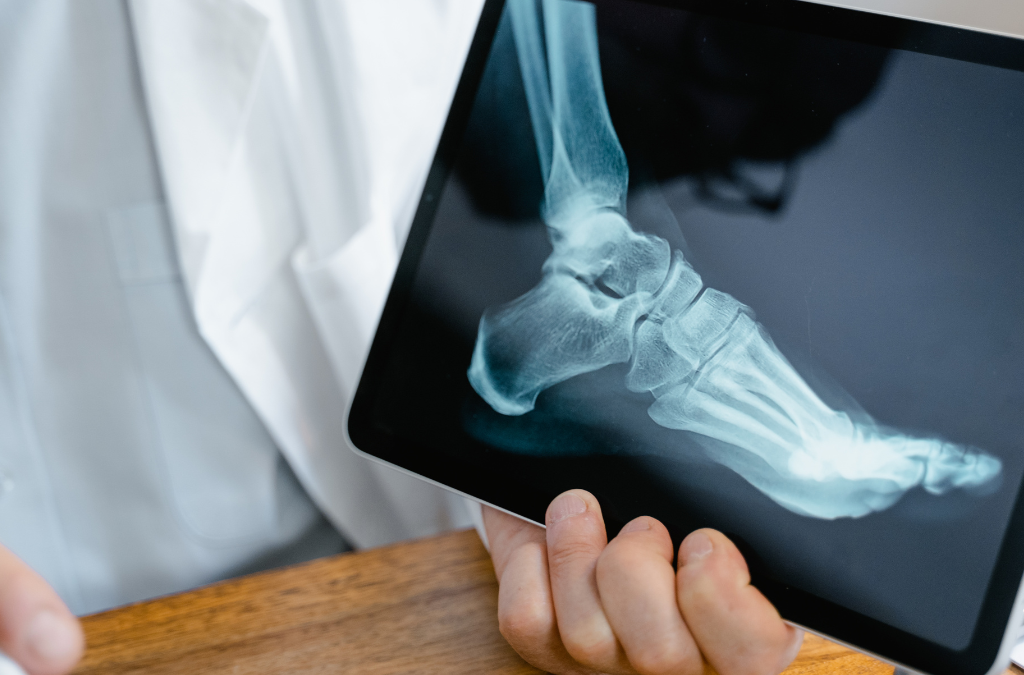
How to Relieve a Stiff Neck After Waking Up
November 8, 2023
Revolutionizing Spinal Treatment: Kyphoplasty Through the Lens of Orthopedic Expertise
December 14, 2023The Patient’s Guide to Podiatric Surgery: Expectations and Outcomes
In the field of podiatry, surgical procedures are often recommended to address a variety of foot and ankle conditions that cannot be effectively treated with non-invasive methods. While the thought of undergoing surgery can be intimidating for many patients, understanding what to expect from podiatric surgery can help alleviate anxiety and ensure a smooth recovery process. In this comprehensive guide, we will explore the different aspects of podiatric surgery, including the types of procedures, benefits, preparation, post-operative care, possible risks, common outcomes, dealing with pain, and questions to ask your podiatrist before surgery. We will also discuss the role of podiatry in diabetes management.
What to Expect from Podiatric Surgery
Podiatric surgery is a specialized area of medicine focused on diagnosing and treating conditions affecting the feet and ankles. When other conservative treatments have failed to provide relief, or when a condition is severe, podiatric surgery may be recommended. The goal of podiatric surgery is to improve mobility, alleviate pain, and enhance the overall function of the feet and ankles.
Before undergoing podiatric surgery, at Center For Specialty Care, it is crucial for us to make sure all patients have a clear understanding of what the procedure involves, the expected outcomes, and the recovery process. This will help you make informed decisions and set realistic expectations.
Understanding the Types of Podiatric Surgery
There are various types of podiatric surgery, each addressing specific foot and ankle conditions. Some of the most common procedures include:
- Bunionectomy: A surgical procedure to remove a bunion, which is a bony bump that forms at the base of the big toe.
- Hammertoe correction: This procedure aims to correct the deformity of the toes, which causes them to bend abnormally.
- Plantar fasciitis release: Surgery to relieve the pain and inflammation caused by plantar fasciitis, a condition characterized by heel pain.
- Heel spur removal: A surgical procedure to remove the bony outgrowth on the heel bone that can cause intense pain.
- Ankle fusion: This surgery is performed to fuse the bones of the ankle joint together, providing stability and reducing pain.
Your podiatrist will determine the most appropriate surgical procedure based on the diagnosis of your specific condition.
Benefits of Podiatric Surgery
Podiatric surgery offers numerous benefits for patients suffering from foot and ankle conditions that significantly affect their quality of life. Some of the key benefits include:
- Pain relief: Surgical intervention can provide long-term relief from chronic pain and discomfort.
- Improved mobility: Podiatric surgery can restore mobility, enabling patients to engage in activities they may have avoided due to pain or limitations.
- Enhanced foot function: By addressing the underlying cause of the condition, surgical procedures can improve the overall function of the feet and ankles.
- Prevention of further damage: Surgery can prevent the progression of certain foot conditions, reducing the risk of complications.
It is important to have a thorough discussion with your podiatrist to understand the specific benefits you can expect from the recommended surgical procedure.
Preparing for Podiatric Surgery
Prior to undergoing podiatric surgery, your podiatrist will provide detailed instructions to help you prepare adequately. These instructions may include:
- Fasting requirements: You may be advised not to eat or drink anything for a certain period before the surgery to reduce the risk of complications during anesthesia.
- Medication management: Your podiatrist will discuss any prescribed medications you should continue or discontinue before the surgery.
- Smoking cessation: If you are a smoker, your podiatrist may strongly recommend quitting before the surgery to promote better healing and reduce the risk of complications.
- Arrangements for transportation and aftercare support: It is important to arrange for someone to drive you home after the procedure and to have someone available to assist you during the initial stages of recovery.
Following your podiatrist’s instructions diligently will help ensure a smooth surgical experience.
Post-Operative Care Following Podiatric Surgery
After podiatric surgery, proper post-operative care is crucial to facilitate healing and ensure optimal outcomes. Your podiatrist will provide specific instructions tailored to your procedure, but some general post-operative care guidelines include:
- Elevating the foot: Keeping the foot elevated above heart level can help reduce swelling and promote circulation.
- Wearing compression stockings: Compression stockings can aid in reducing swelling and preventing blood clots.
- Taking prescribed medications: Your podiatrist may prescribe pain medications or antibiotics to manage pain and prevent infections.
- Following weight-bearing restrictions: Your podiatrist will provide guidance on weight-bearing limitations and the use of assistive devices, such as crutches.
- Attending follow-up appointments: Regular follow-up visits with your podiatrist are essential to monitor your progress and address any concerns.
Adhering to the prescribed post-operative care plan will help optimize your recovery and promote successful outcomes.
Possible Risks and Complications of Podiatric Surgery
As with any surgical procedure, podiatric surgery carries some risks and potential complications. While complications are relatively rare, it is important to be aware of them. Some possible risks include:
- Infection: There is always a risk of infection at the surgical site. Following proper wound care instructions can minimize this risk.
- Delayed healing: Certain factors, such as poor circulation or underlying medical conditions, may hinder the healing process.
- Nerve damage: In rare cases, nearby nerves may be affected during the procedure, resulting in temporary or permanent numbness, tingling, or loss of sensation.
- Allergic reactions: Some individuals may experience allergic reactions to medications, anesthesia, or medical supplies used during the surgery.
Your podiatrist will thoroughly discuss these risks with you before the surgery and take appropriate measures to minimize them.
An Overview of the Recovery Process
The recovery process following podiatric surgery can vary depending on the specific procedure performed and individual factors. In general, it is important to allow your body time to heal and follow your podiatrist’s guidelines for a successful recovery. During the recovery period:
- You may experience some discomfort or pain, which can be managed with prescribed pain medications.
- Swelling and bruising are common after surgery and will gradually subside over time.
- Physical therapy or rehabilitation exercises may be recommended to promote healing and restore strength and mobility.
- It is important to follow any weight-bearing restrictions or use assistive devices as advised by your podiatrist.
- Full recovery varies based on individual factors and the complexity of the procedure, so it is important to be patient and not rush the healing process.
Your podiatrist will provide a detailed overview of the recovery process specific to your surgical procedure and offer guidance and support throughout your journey to recovery.
Common Outcomes of Podiatric Surgery
Podiatric surgery can result in various positive outcomes, depending on the specific condition being treated. Some common outcomes include:
- Resolution of pain and discomfort: Surgical intervention can often provide long-lasting relief from chronic pain associated with foot and ankle conditions.
- Improved range of motion: Corrective procedures can restore normal function and improve range of motion in the affected foot or ankle.
- Enhanced stability: Surgical interventions can address structural abnormalities, providing improved stability and balance.
- Restored quality of life: Successful surgical outcomes can enable patients to return to their normal activities and enjoy a better quality of life.
Your specific outcome will depend on the nature of your condition, the surgical procedure performed, and your commitment to post-operative care and rehabilitation.
Dealing with Pain After Podiatric Surgery
Pain management is an essential aspect of the post-operative period. While some discomfort is expected after podiatric surgery, there are several ways to manage pain effectively:
- Take prescribed pain medications as directed by your podiatrist.
- Follow the recommended icing and elevation protocols to reduce swelling and discomfort.
- Engage in gentle exercises and physical therapy as advised by your podiatrist to promote healing and reduce pain.
- Practice relaxation techniques, such as deep breathing or meditation, to help manage pain and reduce stress.
It is important to communicate any significant or persistent pain to your podiatrist, as it may indicate a potential complication or require adjustments to your treatment plan.
Questions to Ask Your Podiatrist Before Surgery
Before undergoing podiatric surgery, it is crucial to have a comprehensive discussion with your podiatrist. Some important questions to consider asking include:
- What are the potential risks and complications associated with the surgery?
- What specific benefits can I expect from the surgical procedure?
- What is the expected recovery time?
- What are the alternatives to surgery, and why is surgery recommended in my case?
- What type of anesthesia will be used, and what are the associated risks?
Your podiatrist at Center For Soecialty Care, we will address your concerns and provide you with the necessary information to make an informed decision about your treatment.
The Role of Podiatry in Diabetes Management
Podiatry plays a crucial role in the comprehensive management of diabetes. Patients with diabetes are particularly vulnerable to foot complications, such as neuropathy, foot ulcers, and infections. Podiatrists are experts in assessing and managing these conditions to prevent long-term complications. Regular foot screenings, education on proper foot care, and prompt treatment of any abnormalities are essential for individuals with diabetes.
Podiatric surgery may be recommended for diabetes-related foot complications that do not respond to conservative treatments. Surgical interventions can help alleviate pain, correct deformities, and improve overall foot health. However, individuals with diabetes should work closely with their podiatrist and other healthcare providers to ensure optimal management of their condition.
By understanding what to expect from podiatric surgery, you can approach the procedure with confidence and knowledge. Remember to follow your podiatrist’s instructions diligently, attend follow-up appointments, and prioritize post-operative care for a successful recovery. Consultation with a podiatrist is essential to determine the most appropriate treatment plan for your specific foot condition. With proper care and guidance, podiatric surgery can offer the potential for improved foot health and enhanced quality of life.




